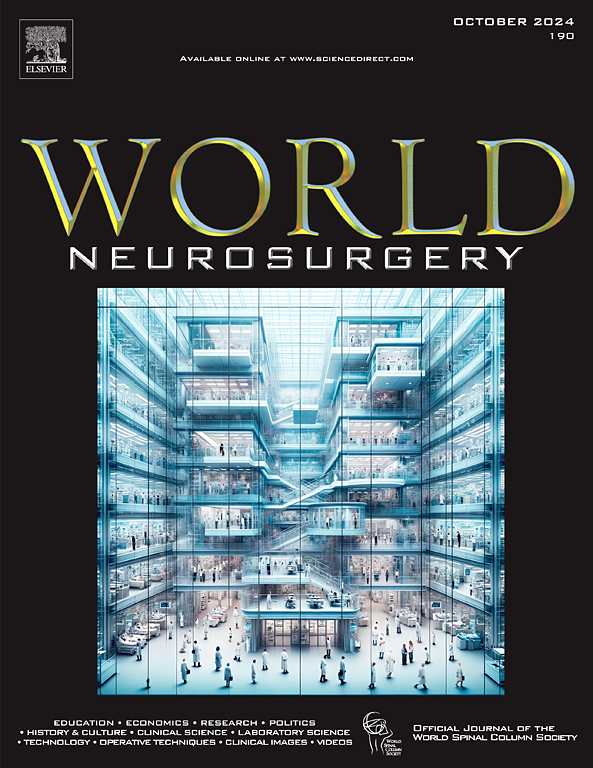Endoscopic Occipital Transtentorial Approach for Dorsal Midbrain Cavernous Malformation: Technical Notes With Illustrative Case
IF 1.9
4区 医学
Q3 CLINICAL NEUROLOGY
引用次数: 0
Abstract
Background
The dorsal midbrain, an anatomically intricate region, presents significant challenges for traditional surgical interventions due to the heightened risk of vascular and neurological injury, and the necessity of brain tissue retraction.
Methods
This study retrospectively reviewed the case of a 29-year-old male diagnosed with a cavernous malformation located in the dorsal aspect of the left midbrain. The patient underwent resection via the endoscopic occipital transtentorial approach (EOTA) in July 2024. Comprehensive records were analyzed, including preoperative magnetic resonance imaging and computed tomography imaging, detailed surgical notes, and postoperative outcomes.
Results
The patient initially presented with headaches and diplopia. Imaging revealed a 17 × 13 mm tumor in the dorsal aspect of the left midbrain, associated with obstructive hydrocephalus. The 2.5-hour EOTA surgery resulted in complete resection of the tumor, with the resolution of headache symptoms and improvement of diplopia. No new complications were reported postoperatively. The patient was discharged 7 days postsurgery without the need for intensive care unit admission. Pathological examination confirmed the diagnosis of a cavernous malformation. Additionally, the EOTA facilitated a concurrent endoscopic third ventriculostomy, and no evidence of hydrocephalus was observed during the 3-month follow-up period.
Conclusions
The EOTA constitutes a significant advancement in neurosurgical techniques for the resection of dorsal midbrain tumors, enhancing surgical precision and safety. This approach contributes to improved patient outcomes and a reduction in complication rates. Further studies are warranted to validate these findings and to establish standardized protocols for the application of EOTA in midbrain tumor resection.
背侧中脑海绵状畸形的内窥镜枕骨经支架入路:技术说明与病例举例。
背景:中脑背侧是一个解剖结构复杂的区域,由于血管和神经损伤的风险较高,且必须牵拉脑组织,这给传统手术干预带来了巨大挑战:本研究回顾性分析了一例被诊断为左侧中脑背侧海绵状畸形的 29 岁男性病例。患者于 2024 年 7 月通过内窥镜枕骨横隔入路(EOTA)接受了切除术。对患者的综合病历进行了分析,包括术前磁共振成像(MRI)和计算机断层扫描(CT)成像、详细的手术记录和术后结果:患者最初出现头痛和复视。影像学检查显示左侧中脑背侧有一个17x13毫米的肿瘤,并伴有梗阻性脑积水。经过 2.5 小时的 EOTA 手术,肿瘤被完全切除,头痛症状得到缓解,复视也有所改善。术后没有出现新的并发症。患者术后七天出院,无需入住重症监护室。病理检查证实了海绵畸形的诊断。此外,EOTA还有助于同时进行内镜下第三脑室造口术,并且在三个月的随访期间未发现脑积水迹象:结论:EOTA是神经外科技术在中脑背侧肿瘤切除术方面的重大进步,提高了手术的精确性和安全性。这种方法有助于改善患者预后,降低并发症发生率。为了验证这些研究结果,并为中脑肿瘤切除术中的EOTA应用制定标准化方案,我们有必要开展进一步的研究。
本文章由计算机程序翻译,如有差异,请以英文原文为准。
求助全文
约1分钟内获得全文
求助全文
来源期刊

World neurosurgery
CLINICAL NEUROLOGY-SURGERY
CiteScore
3.90
自引率
15.00%
发文量
1765
审稿时长
47 days
期刊介绍:
World Neurosurgery has an open access mirror journal World Neurosurgery: X, sharing the same aims and scope, editorial team, submission system and rigorous peer review.
The journal''s mission is to:
-To provide a first-class international forum and a 2-way conduit for dialogue that is relevant to neurosurgeons and providers who care for neurosurgery patients. The categories of the exchanged information include clinical and basic science, as well as global information that provide social, political, educational, economic, cultural or societal insights and knowledge that are of significance and relevance to worldwide neurosurgery patient care.
-To act as a primary intellectual catalyst for the stimulation of creativity, the creation of new knowledge, and the enhancement of quality neurosurgical care worldwide.
-To provide a forum for communication that enriches the lives of all neurosurgeons and their colleagues; and, in so doing, enriches the lives of their patients.
Topics to be addressed in World Neurosurgery include: EDUCATION, ECONOMICS, RESEARCH, POLITICS, HISTORY, CULTURE, CLINICAL SCIENCE, LABORATORY SCIENCE, TECHNOLOGY, OPERATIVE TECHNIQUES, CLINICAL IMAGES, VIDEOS
 求助内容:
求助内容: 应助结果提醒方式:
应助结果提醒方式:


